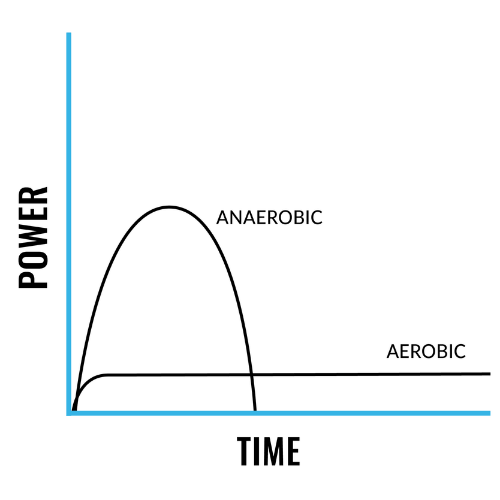THE DIFFERENCE BETWEEN AEROBIC & ANAEROBIC TRAINING
It can be challenging to understand the difference between aerobic and anaerobic training.
While the words themselves are very similar, the difference between these two training methodologies is vast.
This article will explain the difference between the two in order to help you broaden your knowledge of energy system training.
Table of Contents:
The Difference Between Aerobic and Anaerobic Training
The difference between aerobic and anaerobic training is the fuel source. Aerobic training uses oxygen to create ATP to power the lungs and muscles. Anaerobic training is more intense and demands a faster energy source. Therefore, the body produces and then uses lactate as its fuel source, fed by glycogen.
In the gym, these types of training look very different. Aerobic work is sustainable in nature, often longer and slower, while anaerobic training is unsustainable in nature, and very fast and powerful.
Aerobic Training
Aerobic Training
Anaerobic Training
2 Sets:
15 Minute Airbike @ 50 RPM
10 Minutes Rest
100m Row all out x 10 sets, 2 minutes between – Damper 5
Anaerobic Training
2 Sets:
15 Minute Airbike @ 50 RPM
10 Minutes Rest
100m Row all out x 10 sets, 2 minutes between – Damper 5
Aerobic Training Defined
Aerobic training is exercise that builds the aerobic system and develops the efficiency of the lungs, muscles, and blood.
It primarily uses oxygen as fuel. This type of training is long, slow, and always sustainable. Examples include a 60-minute walk or bike at a conversational pace and shorter mixed modal or cyclical intervals at a repeatable pace.
Benefits of Aerobic Training
Aerobic training improves how efficiently one can produce energy.
In all forms of movement, the aerobic system is activated at some level. Therefore, a robust aerobic system prepares one for all other types of movements.
Example Aerobic Training Session
Cyclical Aerobic Session
3 Sets:
10 Minute Assault Bike @54 RPM
5 Minutes Rest
Mixed Modal Aerobic Session
3 Sets:
10 Minute AMRAP @ sustained:
5 Burpees
10 Calorie Row @ 2:10/500m
5 Minutes Rest
Anaerobic Training Defined
Anaerobic training is any exercise done without the presence of oxygen. This type of exercise primarily uses lactate as a fuel source. It is defined by efforts that are at an unsustainable level of work and with the presence of lactate. Lactate is the byproduct of intense work and will begin to accumulate at a significant level as intense efforts are extended out beyond 15-20 seconds.
(Coach's Resource: Learn how to create anaerobic workouts in this free course.)
Benefits of Anaerobic Training
There are three main benefits of anaerobic training.
Firstly, since it is stressful, it can be used to teach the body how to adapt to stress. This is beneficial for those who have to deal with stress for performance, like elite athletes.
Secondly, it creates a massive metabolic response. However, this does not necessarily mean long-term positive metabolic effects, because if this type of heightened stress response is overtrained, the stress of being in survival mode can overload the system.
Thirdly, it can provide a booster to the aerobic system, which improves the ability to perform and recover when working near threshold pace.
Example Anaerobic Training Session
Cyclical Anaerobic Training
40 second Row for calories
Rest 4 minutes 40 seconds
Mixed Modal Anaerobic Training
5 Sets @ hard effort:
5 Power Clean @ 65% of one rep maximum
6 Bar Facing Burpees
20 Calorie Assault Bike
Rest 6 minutes
When to Use Each Type of Training
Aerobic Training
Everyone can benefit from aerobic training. As mentioned earlier, a robust aerobic system has a variety of benefits and will improve anyone’s performance and function in their daily lives or goal-oriented fitness journeys.
Anaerobic Training
Anaerobic training is only appropriate for specific intermediate to advanced clients who are strong enough to express it.
When considering who to program anaerobic training for, the function of the individual must be considered. Anaerobic training is most relevant for mixed modal athletes, some sports performance, and for specific occupations that need to be able to tolerate high levels of stress.
Due to its short and intense nature, it is tempting to utilize this type of training for general population clients who have limited time to train. However, if incorrectly performed, this type of training can detract from health and longevity and burn clients out quickly. It is not recommended for general population clients who want long-term and consistent results.
Learn How to Program and Progress Anaerobic Training
Anaerobic training is a powerful tool when used correctly.
But how do you know if high-intensity training is right for your client’s goals?
Moreover, once you begin the training program, how do you progress it over time while avoiding burnout?
Sign up for this free course and learn when to use anaerobic training, and when to avoid it. Through course videos and a downloadable guide, you’ll develop a systematic and smart approach to progressing intensity so your clients can perform at their best.


